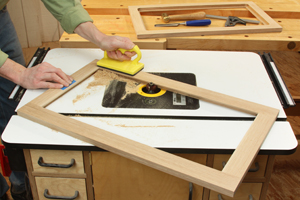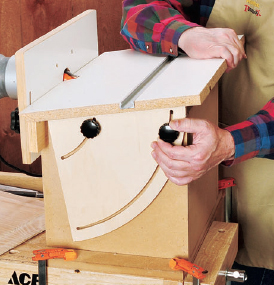
I have been reading articles about router tables and different router lifts. Can you explain the advantages between a horizontal-mounted router and a vertical-mounted router? Do they have special purpose for which one would be better than the other? And do router bits work better in one setup than the other? – Clayton Stolls
Chris Marshall: A “vertical” mounted router table is the conventional orientation, where the router’s base is embedded in a tabletop, usually hanging from an insert plate, and the bit projects up through the table vertically (see photo, left). Any router bit style will work with a vertical configuration like this, so it’s my choice. A “horizontal” style setup (see photo, below) is where the router fits into a vertical mount, so the router base is perpendicular to the table. In this horizontal configuration, the bit projects parallel to the tabletop, making it particularly useful for cutting tenons on long workpieces: you don’t have to stand them up on end for routing, where they’re less stable. Instead, just lay the workpiece on its face against a miter gauge and feed it past the bit. Some horizontal-mounted router tables also offer the advantage of being able to plunge the bit into the workpiece by moving the table with the workpiece clamped to it — so, mortising made easier — or tipping the tabletop in order to present the router bit at an angle to the workpiece for making angled cuts or angled joinery without employing other special jigs.
If I were cutting lots of mortise and tenon joints on oversized parts, and if I didn’t have a benchtop mortiser or a dado set for my table saw, the horizontal style of router table would be more appealing to me. But, since I have these other machining solutions, the vertical “common” style of router table meets all of my profiling and joinery needs pretty well.
Tim Inman: My experience is only with vertical mounted routers in tables. Their use is so similar to that of a shaper table I find that is my preference. Old habits? Make gravity your friend. A router is an incredibly versatile tool. Placed vertically in a table, it acts like a shaper. Used “handheld” as it was originally designed, it acts like a motorized plane. Put into a table and held on the horizontal, the router would take on some of the characteristics of a jointer. So, what do you want to do with your router most? I think that should be your guiding question. If edge forming, decorative shaping and the like is your task, I would suggest the conventional vertical alignment. You can do just about anything either way, though.






